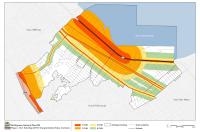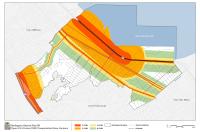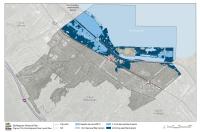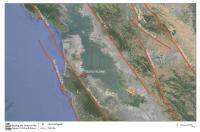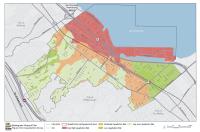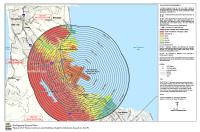Emergency Preparedness, Disaster Response, and Community Resilience
Burlingame—like all cities in the Bay Area—is exposed to a variety of natural and human-caused hazards that require consideration in emergency response planning. The environmental features that contribute to Burlingame’s scenic qualities and great places to enjoy nature have been created by earthquake faults, steep slopes, wooded hillsides, and San Francisco Bay, all of which pose potential hazards. Catastrophic earthquakes, landslides, flooding, wildland and urban fires, and liquefaction represent natural hazards that must be addressed in any planning process. Human-caused hazards include energy instability and threats of terrorism.
Preparing for potential disasters and having adequate response strategies in place are not solely the responsibility of our government, although we place a high degree of reliance upon local, regional, statewide, and national agencies and systems. We anticipate that proper emergency preparedness and disaster response from government agencies means that they will have the necessary equipment and resources to respond to a disaster and to maintain public health and welfare without regular services (such as water and electricity) during the following recovery period.
We also recognize that having a resilient community enables a city to recover more quickly from a disaster and that private businesses, individual citizens and volunteer organizations and associations play a critical role. In the event of a major disaster City emergency responders and City resources will be focused on the major incidents and infrastructure and residents will need to be able to support each other from 24 up to 72 or more hours.
This goal and supporting policies are designed to prepare residents and businesses for disasters, and to ensure that the City of Burlingame and other government agencies are ready to respond to protect lives and property in the event of an emergency, and to build a more resilient community.
Goal: CS-3
Protect Burlingame residents, property, and businesses by ensuring preparedness for, and effective response to, natural and human-caused disasters.
Develop, maintain, and implement a citywide Energy Assurance Plan that documents the energy needs of critical City and community facilities and functions, establishes goals and actions to increase energy resiliency during disasters, and prioritizes the use of renewable energy or other sustainable technologies to reduce dependency on the grid during power outages.
Coordinate with the Peninsula Corridor Joint Powers Board (Caltrain) and the California High Speed Rail Authority to ensure that new train services, including electrification and higher speeds, do not result in overburdened safety risks to the community both in terms of infrastructure and access (e.g., rail street crossing closures).
Support a Community Risk and Resiliency position that would be responsible for:
- Leading community engagement and education about safety, disaster preparation and resilience;
- Bringing stakeholders together, including HAM radio operators, CERT, the Burlingame Neighborhood Network, the Central County Fire Department, Burlingame Police Department, the City Manager, and the City Council to build a vision, plan and establish goals to increase the City’s resilience to emergencies;
- Bringing best regional, state and national practices to Burlingame; and
- Developing recommendations to mitigate identified risks.
Publish and promote emergency preparedness activities and drills. Use the City’s social media accountsand website to provide safety tips that may include identifying and correcting household hazards, knowing how and when to turn off utilities, helping family members protect themselves during and after an earthquake, recommending neighborhood preparation activities, and advising residents to maintain an emergency supply kit containing first-aid supplies, food, drinking water, and battery- operated radios and flashlights.
Participate in Community Emergency Response Team (CERT) training and offer training to help neighborhood groups care for themselves during disasters. To this end, partner with the Burlingame Neighborhood Network (BNN) to assist with neighborhood drills and safety exercises to increase participation and build community support.
